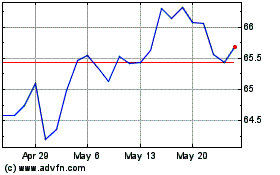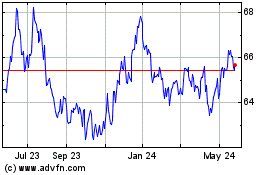The global economic uncertainties revolving around the European
debt crisis and the general slowdown in most economies have
resulted in an increase in volatility in many stock markets. The
currency market is no exception to this phenomenon, especially
given the shaky position of many national balance sheets (read
Three Low Beta ETFs for the Uncertain Market).
Deepening worries over the overall health of the global economy
has caused massive sell offs in the risky asset segment. As a
result, the equity markets could not extend their gains that they
posted in the first quarter of 2012.
This risk aversion had increased the demand for the U.S Dollar
(USD) denominated Treasury bonds due to their ‘safe haven’ nature.
Due to this, the yields were depressed and the USD appreciated
against other major currencies (see Where Do You Go For
Yield?).
In particular, from the currency ETF space, things have not been
at their best this fiscal year. Most exchange traded products from
this segment have slumped badly on a year-to-date basis. However,
some ETF from this space have shown resilience in the face of
troubled times and have managed to beat out the dollar in
year-to-date terms.
Below, we highlight three funds that have had a solid start to
the year and could be worth a closer look by investors searching to
either short some strong performers or go long based on strong
momentum:
CurrencyShares Australian Dollar Trust ETF
(FXA)
Launched in June of 2006, FXA tracks the relative movement of
the Australian dollar (AUD) relative to the USD. The funds in this
product are denominated in AUD and kept in a bank account, and the
interest thus received is used to pay for the expenses and fees of
the fund. The fund looks to generate returns through the bank
interest and any capital appreciation that may occur on account of
AUD appreciating versus the USD.
As far as the current scenario is concerned, the benchmark
interest rate is 3.50% and the Consumer Price Index has jumped by
10 basis points for the March 2012 quarter. The Reserve Bank of
Australia (RBA) had slashed interest rates four times since
November 2011 onwards.
The rate cuts add up to 1.25% cumulative. From its 3 year high
at 4.75%, the interest rates have come down to 3.50% on account of
these four subsequent rate cuts.
The falling commodity prices have gone a long way in hurting the
Australian economy as industrial consumption demand for these
commodities have significantly reduced from manufacturing
powerhouses like China (read China Small Cap ETFs Holding Their
Ground).
Still, due to the relatively high interest rate, the RBA will
have a number of policy options going forward, giving it more room
than many of its counterparts.
Nevertheless, FXA has risen by about 4.2% year-to-date, a solid
figure given the uncertainty in the Australian market.
Additionally, due to the high interest rate, the yield on this fund
looks to also be supportive of further gains.
Yet with that being said, the product does have Zacks ETF Rank
of 4 or ‘Sell’ so gains may be hard to come by in the near future.
However, it does remain one of the best options for investing in
the space, charging just 40 basis points in fees and possessing a
relatively high average trading volume as well (see Four Vanguard
ETFs for Long-Term Investors).
Market Vectors Indian Rupee/USD ETN
(INR)
Launched in March of 2008, the Market Vectors Indian Rupee/USD
is an Exchange traded note issued by Morgan Stanley that seeks to
capture the essence of the S&P Indian Rupee Total Return Index.
The index tracks the performance of the Rupee relative to the
USD.
The Indian economy has been under some pressure as of late
although the rupee has held up rather well. INR has added about
2.4% so far in 2012, which is relatively solid given the
uncertainty in the country’s economy (see Indian Rupee ETFs: Is The
Slide Over?).
However, unlike many other economies in the region, India’s
problems are mainly home driven rather than due to external
factors. Policy paralysis, weak infrastructure and little to no
structural reforms in the nation are all cited as some of the
biggest roadblocks to more Indian growth and do not appear to be
going away anytime soon.
Furthermore, a GDP growth rate at a nine year low of 5.3% for
the January-March quarter proves this, while a high current account
and fiscal deficit do not help matters either.
Amidst all negativity, it is believed that the worst for the
Indian Rupee might be over. The currency is showing signs of
recovery and the Indian stock markets are consolidating and
bottoming out on market rallies.
Growth in Industrial production also hints towards an economic
recovery. However, little can be said about its implications in the
actual GDP numbers (read Emerging Market Small Cap ETFs: Freefall
Continues).
Given these facts, INR might be an interesting choice for
investors. The product has $2.62 million in total assets and
charges investors 55 basis points in fees and expenses. The product
being an Exchange traded note, it will not have any tracking error
as it does not incur buying and selling of securities. However, it
is subject to credit risk of the issuer.
The senior debt credit rating of the issues stands at A+ and A2
by rating agencies Standard and Poor and Moody’s, respectively, but
S&P has a negative outlook towards its long-term debt. Year to
date, the note has added about 2.4% and currently has a Zacks ETF
Rank of Strong Buy or 1, suggesting it could be poised for more
gains in the months ahead as well.
PowerShares Deutsche Bank G10 Currency Harvest ETF
(DBV)
DBV is an actively managed ETF, which relies on a long short
portfolio strategy. It works with a small universe of currencies of
countries that comprise the G-10 nations. These currencies include
U.S Dollars, Euro, Japanese Yen, Canadian Dollars, Swiss Francs,
British Pound, Australian Dollar, New Zealand Dollar, Norwegian
Krone and Swedish Krona.
It basically tries to profit from the difference in interest
rates of these countries. The strategy involves borrowing funds in
a currency offering low interest rate and parks the proceeds in a
currency that offer high interest rates.
Thus the ETF tends to profit from this discrepancy in the
interest rates between the various economies. This type of trade is
known as “Carry Trade” which involves active portfolio monitoring
(read Bet Against the dollar with These Three Currency ETFs).
This could be an intriguing investment style as some studies
have found that high yielding currencies tend to hold up better
than their low rate counterparts. If this trend continues, it could
provide the fund with solid returns that are generally uncorrelated
to the broad market. In fact, DBV is up by about 4.2% so far in
2012.
The ETF debuted in September of 2006 and since then has managed
to amass $294.05 million. It charges a steep expense ratio of 75
basis points mainly thanks to its actively management. The product
also has a solid volume level as, on average, approximately 187,000
shares of DBV exchange hands on a daily basis.
Want the latest recommendations from Zacks Investment Research?
Today, you can download 7 Best Stocks for the Next 30
Days. Click to get this free report >>
PWRSH-DB G10 CU (DBV): ETF Research Reports
CRYSHS-AUS DOLR (FXA): ETF Research Reports
MKT VEC-RUPEE (INR): ETF Research Reports
To read this article on Zacks.com click here.
Zacks Investment Research
Want the latest recommendations from Zacks Investment Research?
Today, you can download 7 Best Stocks for the Next 30 Days. Click
to get this free report
Invesco CurrencyShares A... (AMEX:FXA)
Historical Stock Chart
From May 2024 to Jun 2024

Invesco CurrencyShares A... (AMEX:FXA)
Historical Stock Chart
From Jun 2023 to Jun 2024
